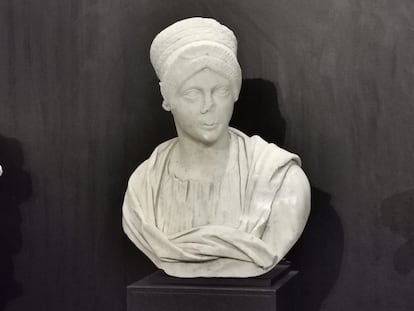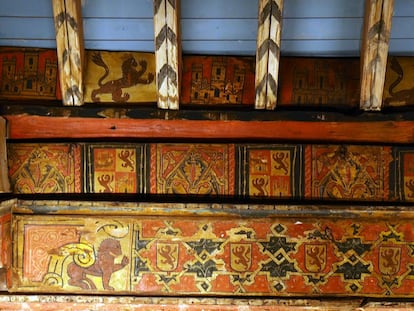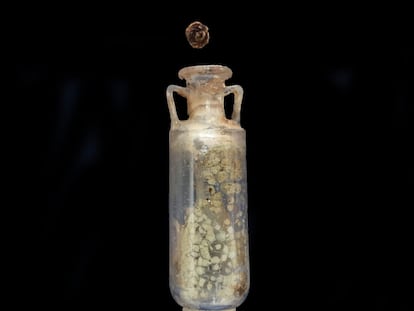A treasure trove of 119 archaeological pieces was hidden in a storage room in Córdoba, Spain
The Spanish Civil Guard police recovered a marble bust of a female ‘of similar artistic quality to the ones exhibited in the Louvre’ and arrested a couple accused of crimes against historical heritage


The Roman marble female bust-portrait was kept in a storage room in Baena (Córdoba), Spain. The experts advising Spain’s Civil Guard police describe it as “a unique and absolutely exceptional piece of artistic quality, similar to those exhibited in major museums like the Louvre and the Capitoline in Rome.” This Monday, the armed forces announced that, as part of the so-called Operation Plotina, they have arrested two people who are charged with allegedly committing crimes against historical heritage — smuggling and receiving the same — and that they have recovered 119 extraordinarily valuable archaeological pieces. Operation Plotina is part of the international Pandora VII operation, conducted by Spain’s Civil Guard police, Europol and Interpol to combat the illicit trafficking of cultural property in Europe. The international operation has resulted in 60 people arrested, 237 people under investigation and 11,049 seized cultural assets.
The Spanish Civil Guard police explains that after numerous interviews with sources, meetings with collectors, attendance at specialized art forums and periodic inspections of premises and establishments for purchasing and selling cultural goods, it learned about a couple with a police record that might be engaged in the internal trade of cultural goods on the black market. “Within the closed and complex world of the art market, we found that the people we investigated were living a normal — not luxurious — life, acting at different times of the day to go completely unnoticed and put the historical goods on the black market, thereby obtaining great financial benefits,” the agents said in a statement.
After several months of surveillance, the authorities finally located some of the plundered archaeological pieces in a storage room in the Spanish municipality of Baena (Córdoba). Investigators were surprised to find Roman sculptures, architectural elements from the 7th century, absolutely exceptional ceramics and exceedingly rare ancient Greek, Iberian and Roman coins.
The most striking piece was the aforementioned Roman female bust. “It is a private portrait from the first third of the second century that follows portrait models of imperial princesses; based on the type of hairstyle, it is similar to that of Salonina Matidia, the niece of Trajan and the mother of Vibia Sabina, Hadrian’s wife,” the press release says. In addition to the sculpture, the Civil Guard also discovered “a late-antique Corinthian limestone piece from the 7th century. This architectural element matches a [rare] typology. Its carving is of exceptional quality.”

The Museum of Córdoba, under the direction of archaeologist Lola Baena, says that “it is an absolutely exceptional piece. It depicts a young woman dressed in a tunic and cloak, the folds and movement of which are carved with great skill. Her head is slightly tilted to the left, her neck is long and slender, and her features conform to a realistic idealized representation, a feature that characterizes Roman portraiture from the High Imperial period (1st-3rd centuries) from Augustus onward. The piece is unquestionably exceptional, and it is on par with the best second-century Roman sculpture made in Hispanic workshops, as well as close to the quality of those from Rome itself.”
A Roman Republican silver coin from after 44 B.C stands out among the coins seized by the authorities. It is a denarius coin that matches the type of coins issued by Brutus, one of Caesar’s assassins, that were meant to pay his army in the war against Octavian. They note that it is ”very rare coinage, of which very few specimens have been preserved.”
Now recovered, the pieces have been transferred to the Archaeological Museum of Córdoba for custody, conservation and expertise. The Andalusian government’s Ministry of Tourism, Culture and Sport has been involved in this operation through the participation of two expert archaeologist-curators from the Archaeological Museum of Córdoba.
The people arrested and investigated in this operation have been brought to court for the alleged illegal trafficking of archaeological property belonging to Spanish Historical Heritage, smuggling and receiving archaeological material by plunder.
Sign up for our weekly newsletter to get more English-language news coverage from EL PAÍS USA Edition
Tu suscripción se está usando en otro dispositivo
¿Quieres añadir otro usuario a tu suscripción?
Si continúas leyendo en este dispositivo, no se podrá leer en el otro.
FlechaTu suscripción se está usando en otro dispositivo y solo puedes acceder a EL PAÍS desde un dispositivo a la vez.
Si quieres compartir tu cuenta, cambia tu suscripción a la modalidad Premium, así podrás añadir otro usuario. Cada uno accederá con su propia cuenta de email, lo que os permitirá personalizar vuestra experiencia en EL PAÍS.
¿Tienes una suscripción de empresa? Accede aquí para contratar más cuentas.
En el caso de no saber quién está usando tu cuenta, te recomendamos cambiar tu contraseña aquí.
Si decides continuar compartiendo tu cuenta, este mensaje se mostrará en tu dispositivo y en el de la otra persona que está usando tu cuenta de forma indefinida, afectando a tu experiencia de lectura. Puedes consultar aquí los términos y condiciones de la suscripción digital.
More information
Archived In
Últimas noticias
New York enters the era of Zohran Mamdani
Welcome to the post-religion era: The idea of Christianity as the absolute truth has become obsolete
‘I thought you would like it’: The risky sexual practice popularized by TV shows and TikTok
The digitalization of tourism: ‘They promise experiences and gave us the worst possible one’
Most viewed
- Sinaloa Cartel war is taking its toll on Los Chapitos
- Reinhard Genzel, Nobel laureate in physics: ‘One-minute videos will never give you the truth’
- Oona Chaplin: ‘I told James Cameron that I was living in a treehouse and starting a permaculture project with a friend’
- Why the price of coffee has skyrocketed: from Brazilian plantations to specialty coffee houses
- Silver prices are going crazy: This is what’s fueling the rally










































